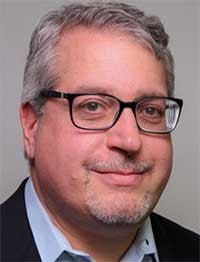Executive Insights: Steven Carlini from Schneider Electric
The Data Center Frontier Executive Roundtable features insights from industry executives with lengthy experience in the data center industry. Here’s a look at the insights from Steven Carlini of Schneider Electric.
STEVEN CARLINI, Schneider Electric
Steven Carlini is Vice President of Innovation and Data Center, with the Energy Management Business Unit of Schneider Electric. With extensive global experience, Steve leads the Energy Management BU’s Office of Innovation and Data Center Solutions, a team focused on spearheading Schneider’s data center, digital energy, and residential businesses. In 2020, he was named to Data Economy’s Future 100, the top 100 people to watch in the next decade who are posed to heavily influence the direction and transformation of the global data center and cloud markets. He is a member of the World Economic Forum’s 5G-Next Generation Networks Programme. Results-oriented, Steven transforms ideas into products, solutions and systems. His areas of focus include 5G and 6G, cloud and edge computing, AI, DCIM, BMS, EDMS and HVAC.
Here’s the full text of Steven Carlini’s insights from our Executive Roundtable:
Data Center Frontier: Is liquid cooling gaining traction? What are the key factors that will guide whether liquid cooling technologies see greater adoption?
Steven Carlini: Liquid cooling is the most effective way to cool rising chip densities that are seen in applications like machine learning and AI servers. It proposes a more efficient alternative to air cooling and decreases the overall carbon footprint. Factors impacting adoption include rack densities, pressure to reduce energy consumption, space constraints, water usage restrictions, and harsh IT environments.
Currently, there are five competing liquid cooling technologies with varying degrees of complexity and effectiveness. I predict one or two technologies may emerge as leaders in the next five years, which would benefit economies of scale and pave the way to broader acceptance.
Data Center Frontier: Cloud, colo, on-premises and edge … deployment options abound. What trends are you seeing in where customers are deploying workloads, and how are these decisions changing?
Steven Carlini: Cloud companies have maxed out their organic design and build staff and are partnering with the intention to grow. We are seeing record-setting capacity deployments, capacity permitting, and absorption rates (available space divided by sold or leased space) in large data centers. There is a changing business model in colocation data centers from building on spec to find an anchor tenant towards building to suit a specific internet giant.
The days of 100 megawatt and larger single tenant data centers are coming, and at the same time, we are seeing the extension of the cloud to local edge and the codification of telco at the edge as well. Other local edge applications growing fast are retail, transportation and manufacturing.
All in all, the industry is changing dramatically as the digital transformation takes hold and larger data needs persist.
Data Center Frontier: After several years of active discussion of diversity and inclusion, how is the data center industry doing? What additional steps are needed to make a bigger difference?
Steven Carlini: At Schneider Electric, data centers represent 16% of our business. Our ambition is to offer equal opportunities to everyone everywhere, and we want our employees —no matter who they are or where they live —to feel uniquely valued.
For the 5th year in a row, Schneider Electric has been included in the Bloomberg GEI, promoting public commitment to equality and advancing women in the workplace. Schneider Electric is one of 418 global companies and one of 20 in the industrial sector. By embracing differences, Schneider Electric builds a culture of respect where everyone feels safe to be their authentic selves. We are 100% committed to inclusion and our policies reflect this commitment to our employees. On July 1, 2021, our Executive Committee passed an important milestone: seven of its 16 members (44%) are women. That means Schneider Electric will be led by one of the most gender-balanced senior management teams among the 40 biggest listed companies in France. In fact, this is in spite of the fact that we operate in a sector that is not typically very gender balanced.
As part of our 2025 sustainability goals, Schneider Electric has committed to ensuring that 50% of new hires are women. That’s up from around 43% now. We also aim to improve our hiring practices so that 40% of our frontline managers and 30% of our senior leaders are women, up from about one-quarter now.
Data Center Frontier: Will microgrids play a larger role as the data center industry addresses power constraints in some key markets? What problems could they address?
Steven Carlini: Microgrids offer resilient and sustainable power for data centers to operate independently of the grid during outages and times of crisis. Microgrids help data centers navigate heightened demand and aging infrastructure to ensure mission critical operations stay consistent despite grid uncertainty. Not only do they offer renewable energy sources, but also enable on-site energy for cost savings.
As microgrids proliferate, data center operators will be able to leverage software to automate the selection of power sources based on their desired criteria, including resiliency, redundancy, energy cost, and even sustainability.
